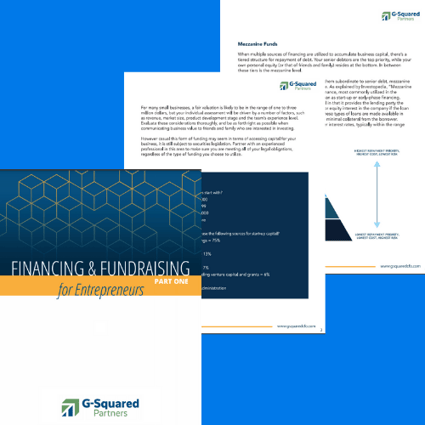#8. Mezzanine Funds
When multiple funding sources are utilized to accrue business capital, there’s a tiered structure for repayment. Your senior debtors are the top priority, while your equity (or that of friends and family) resides at the bottom. In between these tiers is the mezzanine level.
Because the terms of mezzanine loans make them subordinate to senior debt, mezzanine financing options are typically more expensive. As explained by Investopedia, “Mezzanine loans are a combination of debt and equity financing, most commonly utilized in the expansion of established companies rather than as a start-up or early-phase financing.
This type of funding is similar to debt capital in that it provides the lending party the right to adjust terms to access ownership or equity interest in the company if the loan is not paid back fully and on a timely basis.
These loans are made available in a short time frame and usually require only minimal collateral from the borrower. Mezzanine loans command significantly higher interest rates, typically within the range of 20-30%.

#9. Simple Agreement for Future Equity (SAFE)
One type of funding option that has become popular in Silicon Valley but remains rare in other parts of the country is the SAFE agreement. These are often utilized in crowdfunding scenarios.
A bulletin from the U.S. Securities and Exchange Commission (SEC) describes SAFE as an “investment between the investor and the company, in which the company generally promises to give the investor a future equity stake in the company if certain trigger events occur.”
Such events could include when the company next raises investment capital, is acquired, or has an IPO).” Not all SAFEs are the same, and terms of governing the transfer of equity may vary.
Pt. 2: How to Develop a Fundraising Strategy
Jump to:
Fully comprehending your funding strategies is only the first part of the equation. Next, you need to do the work of identifying and attracting fundraising opportunities and begin working on your pitch.
It’s also critical to begin forming (or cultivating) relationships that support your financial needs. Understand that this isn’t a leisurely pursuit. It requires research, practice, and the right skills to engage the right people. The following tips will help you get on the right path.
Be Prepared
Before you run out to sell your pitch, take a step back. It’s never a bright idea to get in front of potential investors too early. Doing so could significantly hurt your chances of raising capital. The first aspect of preparation is deciding which funding options best suit your business’s needs. Early-stage companies, for example, should be talking to seed investors (i.e., friends and family, angel investors, or venture banks). A more mature business interested in growing will want to focus on growth equity investors or commercial banks. Be thorough in your research, and consider speaking with an expert financial professional to identify the most suitable funding types before jumping to action.
Don’t forget: you only get one chance at a first impression. Do everything in your power to make sure you’re completely ready when you go for it. That means developing an engaging presentation, equipping yourself with all relevant information, and practicing your pitch until you’re confident in your ability to deliver.
The Top 10 Traits Investors Look for when Funding a Company
To convince a prospect that investing in your business is a smart move, you have to know which traits will attract investors to your company, what excites them, and what makes them feel safe.
| A Market They Know and Understand |
A Strong Leadership Team |
Investment Diversity |
| Familiarity is an advantage. Startup investors are searching for opportunities in sectors that fit their expertise. Familiarity reduces their risk potential. If they already have an idea of how businesses in your industry become profitable, they won’t have trouble getting on board with the investment it takes to yield a return. |
Leaders with a history of success are apt to be more reassuring to an investor. Show that you have intelligent, strategic, talented leaders, highlighting the proven competency of your founders and management team. |
Many startup investors work with several companies to diversify. Position your business as a unique opportunity with solid growth potential to stand out and be viewed as a distinguished addition to their portfolio. |
| Scalability |
Promising Financial Projections |
Demonstrations of Market Interest |
| Stagnation is not an advantage. Investors look for businesses that are poised to thrive and deliver a worthwhile return. If your company can present a case for adaptability and scalability, it will be more attractive to potential investors. |
It’s essential to crunch the numbers and demonstrate your potential for a healthy financial outlook. These projections should be supported by the details of a financially viable business model. The more time you spend perfecting your financial projections, the more comfortable your investors will feel about taking a chance on you. |
Your offering has to be relevant and desired in the marketplace, and investors will want to see proof of this.
Have you sold your product to anyone yet, or polled your target audience for interest? You should be able to substantiate your claims of market interest to attract investors.
|
| A Detailed Marketing Plan |
Transparency |
Realistic and Reasonable Startup Costs |
|
Regardless of what stage your business is currently operating in, investors will want to see a marketing plan that demonstrates 1) that you know your audience 2) you understand how to reach them.
Ensure you have a robust, innovative marketing plan that utilizes effective mediums and channels to elevate your visibility in the market.
|
You don’t have to dive into every complexity associated with your business effort, but you do need to elicit trust. The best way to accomplish this is by being transparent.
Be open and honest about your company’s realities, including the challenges you face and how you plan to overcome them.
|
Over-projecting your startup’s value can have the opposite effect you’re seeking. If you’re not basing your efforts on startup costs that are realistic for your size and current client base, you could jeopardize potential funding opportunities. Communicate how you intend to use startup funding wisely (and reasonably), avoiding non-essential expenses and common spending temptations. |
| A Long-Term Vision |
|
|
| What are your goals for growth? What are you aiming for in terms of eventual market reach? How quickly and extensively do you plan to scale? Paint a picture of where you see your company headed well into the future, and work on making a connection between those objectives and how you plan to fulfill them. |
|
|
Secure Key Introductions
A warm introduction can be essential to getting in front of the right investor. In fact, a portion of investors will only entertain the idea of an emerging growth company if it is introduced to them by a trusted friend or colleague. Many tune out cold calls and unsolicited pitches, so your investment search’s introduction aspect is fundamental.
This is where the importance of networking shines. You won’t secure investor introductions if you don’t build and utilize a network of connections to those investors. This network can span from friends, family, and former colleagues to fellow entrepreneurs. Keep these contacts sacred and organized.
Sometimes, landing an investment opportunity is a game of numbers. The more introductions you get and pitches you make, the better your odds of securing an investor.
Tell a Good Story
Investors want to be romanced. They have to feel compelled to believe in your business. If they don’t connect with you, they’re not going to put their money in your coffers. Your pitch presentation must be able to draw people into a compelling story.
Telling this story begins with a solid deck, perhaps the single most important tool you have when raising capital and appealing to investors. It should be designed to showcase your business mission, your long-term goals and incremental milestones, how you intend to use the funding, and your future vision.
Take the time to assemble this deck with experienced advisors’ assistance, including all the necessary talking points.

-png.png)



